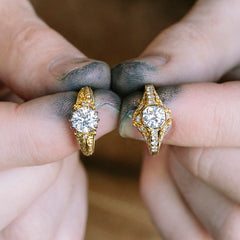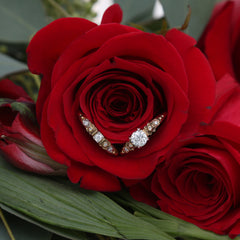When "Poetry in Metal" Was Crafted
 1926 was the year that ‘poetry in metal’ -- Van Craeynest -- was born. Founded by Roger J. Van Craeynest, the company now stands alone in preserving and encompassing the true art form of die-striking jewelry. After studying the incredibly time consuming and delicate art of die-striking, hand-carving and piercing, Roger Van Crayenst opened his factory in Historic San Francisco. Van Craeynest continued to operate and thrive in Northern California until 2010, when each one of their historical dies, working machinery and tools were transported down the coast to Southern California in Redlands. The hand-made factory still operates and creates these masterpieces the same way they were designed and constructed in the early 1900’s to ensure this art form remains alive.
1926 was the year that ‘poetry in metal’ -- Van Craeynest -- was born. Founded by Roger J. Van Craeynest, the company now stands alone in preserving and encompassing the true art form of die-striking jewelry. After studying the incredibly time consuming and delicate art of die-striking, hand-carving and piercing, Roger Van Crayenst opened his factory in Historic San Francisco. Van Craeynest continued to operate and thrive in Northern California until 2010, when each one of their historical dies, working machinery and tools were transported down the coast to Southern California in Redlands. The hand-made factory still operates and creates these masterpieces the same way they were designed and constructed in the early 1900’s to ensure this art form remains alive.
Die-Striking, Chasing and Piercing
 The main techniques used in the Van Craeynest factory are die-striking, chasing and piercing. Die-striking is a method of making jewelry in which gold or platinum is forced into shape between hardened steel dies under 2-10 tons of pressure, depending on the press that is used. The metal is struck "cold" and its molecular structure is actually changed during the process. It becomes much harder and tougher. Each design has its own set of dies. The die making process consists of hand carving an original positive baserelief of the ring into solid steel. This original positive carving called a hub is then hardened and all the dies and other tools to make the ring are derived from it. One can make beautiful jewelry by casting, but you cannot pierce the metal as we do - it is not strong enough, and there may be porosity. Die striking compresses the metal, casting expands the metal - the extra density and strength allows us to work more extensively with the metal allowing much finer detail.
The main techniques used in the Van Craeynest factory are die-striking, chasing and piercing. Die-striking is a method of making jewelry in which gold or platinum is forced into shape between hardened steel dies under 2-10 tons of pressure, depending on the press that is used. The metal is struck "cold" and its molecular structure is actually changed during the process. It becomes much harder and tougher. Each design has its own set of dies. The die making process consists of hand carving an original positive baserelief of the ring into solid steel. This original positive carving called a hub is then hardened and all the dies and other tools to make the ring are derived from it. One can make beautiful jewelry by casting, but you cannot pierce the metal as we do - it is not strong enough, and there may be porosity. Die striking compresses the metal, casting expands the metal - the extra density and strength allows us to work more extensively with the metal allowing much finer detail.
All About Chasing
 Chasing is a technique of modeling and moving gold and platinum in the same way that clay is modeled. No metal is removed during chasing. The craftsman uses a small chasing hammer and tiny hardened steel punches in order to squeeze, move, mold and shape the metal. The hammer handle is about the same length as a carpenter’s hammer, but very thin and the head is only 3/4" long. These steel chasing punches are about half the size of a pencil and each artist owns about 200 different ones. Chasing is used in conjunction with carving to make patterns and deep texture in the metal. Carving and chasing requires a very high skill level and an enormous amount of patience. Some of the rings that we have on display that use this technique are the G.993 and the E.1007.
Chasing is a technique of modeling and moving gold and platinum in the same way that clay is modeled. No metal is removed during chasing. The craftsman uses a small chasing hammer and tiny hardened steel punches in order to squeeze, move, mold and shape the metal. The hammer handle is about the same length as a carpenter’s hammer, but very thin and the head is only 3/4" long. These steel chasing punches are about half the size of a pencil and each artist owns about 200 different ones. Chasing is used in conjunction with carving to make patterns and deep texture in the metal. Carving and chasing requires a very high skill level and an enormous amount of patience. Some of the rings that we have on display that use this technique are the G.993 and the E.1007.
Fine Tuning The Art With Piercing

Lastly, piercing is the removal of metal by cutting it away with a hair-sized saw blade. It is done by drilling very tiny holes into an area of metal, threading the saw blade through the hole, assembling the saw blade into the "saw frame" and cutting out each section by hand. This requires a high level of expertise, and is remarkably focused work. Some examples that we have in our showroom that exemplify this technique are the E.1004, the E.1019 and the E.1020.
These three techniques are the backbone to the artwork that goes into creating each and every piece of ‘poetry in metal.’ Each piece of Van Craeynest jewelry is truly handmade from start to finish. We are proud to have Van Craeynest as a sister company and if you visit our Redlands boutique, you can view our extensive collection of pieces and schedule a factory tour of Van Craeynest.

